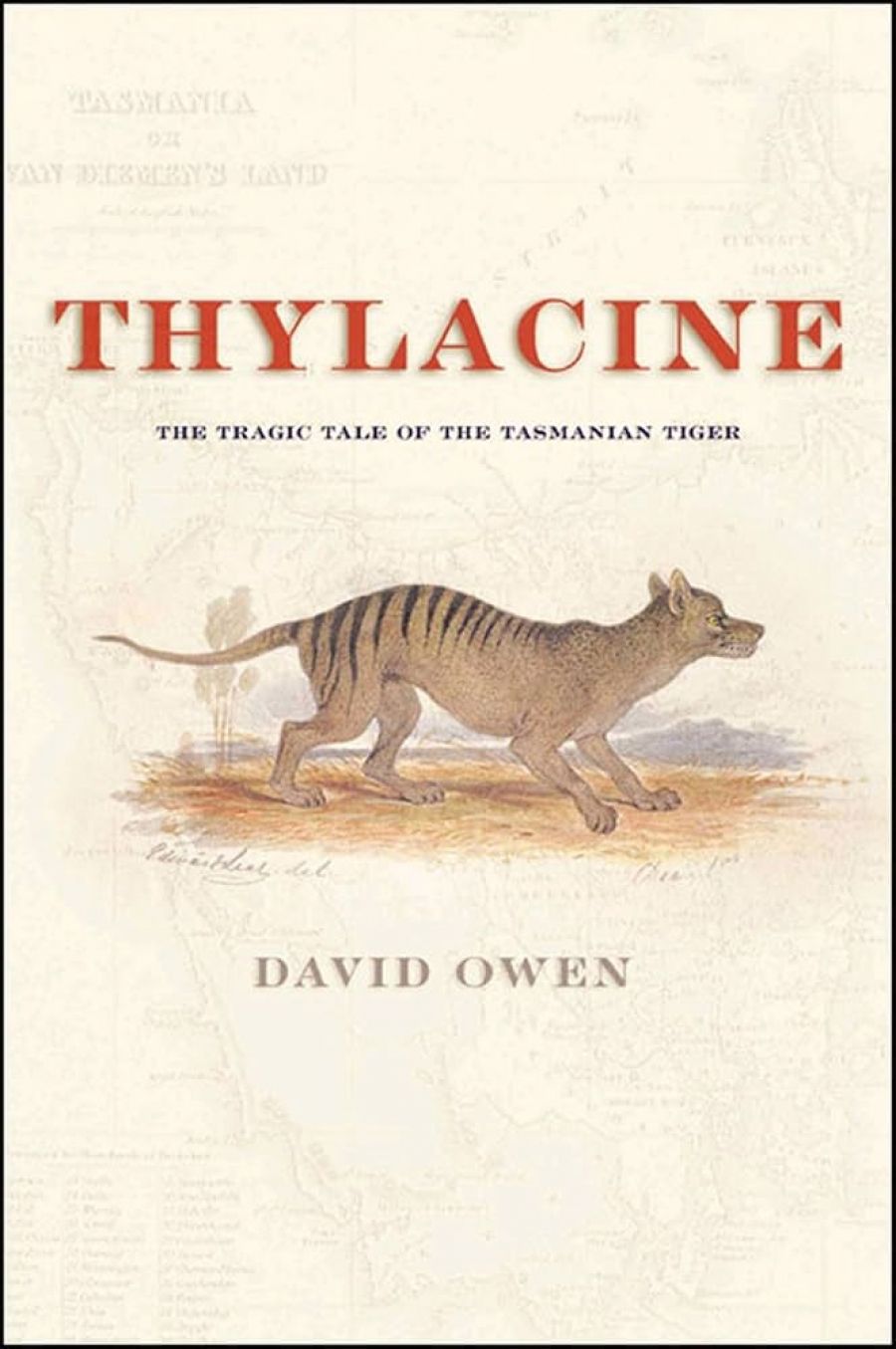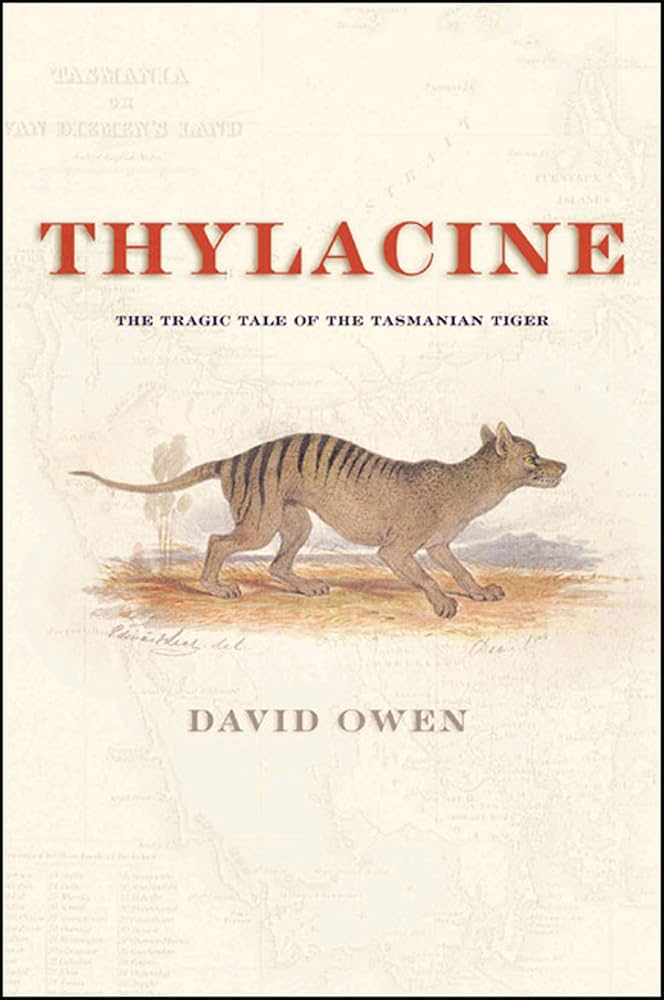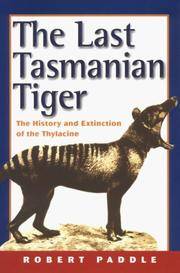
- Free Article: No
- Contents Category: Natural History
- Review Article: Yes
- Article Title: Tenacious Tiger
- Online Only: No
- Custom Highlight Text:
The Tasmanian Tiger or thylacine (Thylacinus cynocephalus) continues to stalk the Tasmanian imagination. Miasmas resembling it figure in reports from tourists and bushwalkers, who happen upon the slinking apparition in the wilderness. Fanciful meanderings of wishful hearts and minds? Perhaps. Tantalising suspicions that the thylacine may still exist will not go away. No matter that the last thylacine died in the Hobart Zoo on 7 September 1936. With it died a species, but not the legend
- Book 1 Title: Thylacine
- Book 1 Subtitle: The tragic tale of the Tasmanian tiger
- Book 1 Biblio: Allen & Unwin, $29.95 hb, 228 pp
- Book 1 Cover Small (400 x 600):

- Book 1 Cover (800 x 1200):

- Book 2 Title: The Last Tasmanian Tiger
- Book 2 Subtitle: The history and the extinction of the thylacine
- Book 2 Biblio: Cambridge University Publishing, $29.95 pb, 283 pp
- Book 2 Cover Small (400 x 600):

- Book 2 Cover (800 x 1200):

In both these books, stringent research has brought the authors to the salient truth that the thylacine is, on available evidence, extinct. There are no contemporary photograph of the animal in the wild since 1936, when the last images of a caged and morose survivor were taken. Nor are there plaster casts of fresh paw tracks. However, the thylacine stubbornly inhabits the minds of those who want to believe.
Robert Paddle’s scholarly book, The Last Tasmanian Tiger, is exhaustive in its detail. He has followed the spoors of the thylacine from early Aboriginal representations to its demise in Hobart. Paddle’s research is well referenced, and his assiduous attention to documentation gives the book a sense of magisterial authority. Such is the interest in this animal, it is unlikely to be the last word on the thylacine, but it is hard to imagine a better-informed scientific voice.
Paddle makes it clear in his introduction that he has examined all the available evidence and provided a measured assessment of it. This may suggest that the book is too science-based and serious for general readers, but this is not the case. Paddle has the skill in presenting a highly developed series of arguments not to ignore lay interest. Here is his declared aim in writing the book:
Within Tasmania, I consider how human–thylacine interactions were constructed in a social, political and cultural context; and how these imperialistic constructions became incorporated into the changing face of Australian colonial science, coming to represent the accepted body of knowledge on the species.
As well as offering a close study of the thylacine in the Tasmanian wilderness and consciousness, Paddle success-fully argues that the way science has dealt with the thylacine was an expression of European thinking. It was a pest, a curious pest no less, and it was dealt with in a summary and, for the time, just way. To explain how this occurred, Paddle depends on the evidence. He does not indulge in speculation. Yet he remarks on odd gaps in the historical record:
Constructing a narrative of the thylacine involves comparing and contrasting different thylacine sources. There are ambiguities, silences, real omissions, pretended omissions and contradictions in the literature. Oral history, visual images and photographs exist beside the written word. In any consideration of the thylacine’s behaviour, these realities need to be acknowledged, argued and explained.
Paddle resists the temptation to mourn the thylacine. He acknowledges that mistakes were made in the way the thylacine was viewed, under-stood and managed, but his scientific focus is never blurred. Part of this can perhaps be explained by his background. He currently teaches at the Australian Catholic University, and has studied animal behaviour and the history and philosophy of science. He presents the persuasive case that, although the thylacine was doomed after the imposition of the bounty (in 1888 one pound for a full adult animal, and ten shillings for a half-grown or partly-grown animal), another force may have hastened its demise – epidemic disease.
The extensive documentation and sources underpinning Paddle’s exploration range from diet to pack behaviour. He gives space to an analysis of a powerful pastoral lobby that blamed the thylacine for sheep loses and agitated for a bounty.
Paddle demonstrates that this view can be largely dismissed. The exchanges between members of parliament over the thylacine and the establishment of the bounty are revealing as to how colonial politics was conducted.
Like Paddle, David Owen defers to published accounts and impressions for his tragic tale of the thylacine. Both writers present abundant endnotes, bibliographical details and comprehensive indexes. Other than using similar sources, the books part company. Owen has a different view of the elusive animal. He resists the temptation to dispel the hopes or suspicions that still exist.
Owen, now a Tasmanian resident, is first and foremost a fiction writer. His Pufferfish series of crime novels indicate that he has a talent for detail and coruscating plots. He handles substantial technical information with fluency and integrity. His chapter ‘In the Beginning, Evolution’ puts the thylacine in its biological context. His careful evaluation of the forces for extinction in the late 1880s is also handled in an accomplished way. But it is in his highly original chapter ‘The Tiger in Art’ that Owen explores new territory.
In recent times, Owen argues, the thylacine has become a much-appropriated animal in literature, advertising and the visual arts. He covers contemporary fiction such as Julia Leigh’s The Hunter, Michael Hyde’s Tyger Tyger and Heather Rose’s White Heart. He also explores the way that the thylacine has come to symbolise Tasmania through Cascade beer and the state’s cricket team, the Tasmanian Tigers. Owen may be on to something even deeper. Tasmania, in adopting an extinct animal as its symbol, may be venting its discomfort over its loss.
Owen also gives space to the Australian Museum’s attempt to reconstruct the thylacine’s DNA and to bring back from extinction a living specimen of the animal. Whether this is feasible remains to be seen, but it is indicative of the interest in the thylacine, and emblematic, too, of the guilt over its premeditated extinction.
Together, these books present a full body of knowledge on the thylacine. Both provide much photographic material, illustrative, informative and poignant. Paddle and Owen have offered important contributions to an unfinished story.


Comments powered by CComment